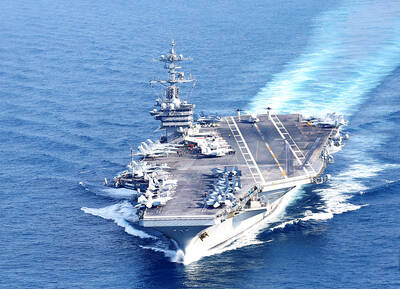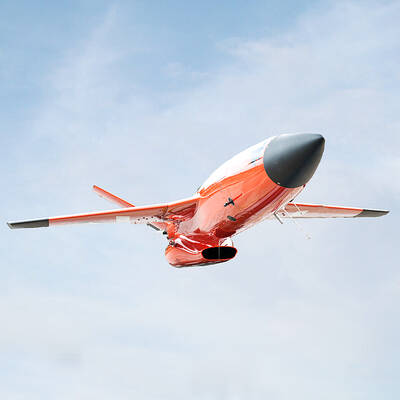Australia plans to increase defense spending by nearly A$30 billion (US$21.6 billion) over the next 10 years, seeking to protect its strategic and trade interests in the Asia-Pacific as the US and its allies grapple with China’s rising power.
Defense spending is expected to reach A$195 billion, or 2 percent of GDP, by 2021-2022, as Australia buys new equipment including frigates, armored personnel carriers, fighter jets, drones and submarines, Australian Prime Minister Malcolm Turnbull told an armed forces audience in Canberra yesterday.
The strategic defense plan was designed in mind of the changing nature of regional security, particularly China’s economic and military rise and an increased US focus on the Asia-Pacific, Turnbull said.
“The United States will remain the pre-eminent global military power over the next two decades,” Turnbull said. “It will continue to be Australia’s most important strategic partner through our long-standing alliance, and the active presence of the United States will continue to underpin the stability of our region.”
The announcement riled Beijing, where the Chinese Ministry of Foreign Affairs expressed “dissatisfaction” with Australia’s “negative” remarks on the South China Sea and its military development.
Tensions between China and Taiwan, Vietnam, Malaysia, Brunei and the Philippines over sovereignty in the South China Sea have risen after China embarked on significant reclamation work on disputed islands and reefs in the area.
China claims most of the South China Sea, through which more than US$5 trillion in global trade passes every year.
Australian Minister for Defence Marise Payne said Canberra welcomed China’s economic rise and noted it would seek greater influence in the region.
“As a major power, it will be important for regional stability that China provides reassurance to its neighbors by being more transparent about its defense policies,” Payne said.
“The government will seek to deepen and broaden our important defense relationship with China while recognizing that our strategic interests may differ in relation to some regional and global security issues,” she said.
Australia has urged China and other claimants to refrain from island-building and militarization in the South China Sea in an effort to lower tensions.
“We hope the Australian side can correctly and positively view China’s development and strategic intent,” Chinese foreign ministry spokeswoman Hua Chunying (華春瑩) said at a regular press briefing later yesterday.
Asked if China wanted to see an arms race in the region, Hua said: “The answer to that is definitely no.”
In addition to detailing the number of new submarines, Payne said Australia would commit to a continuous shipbuilding program starting with nine frigates and 12 offshore patrol vessels.
The supplier of the submarines is to determined later this year.
Reuters reported earlier this month the competition for the A$50 billion contract to build Australia’s next submarine fleet is narrowing to a race between Japan and France. China last week urged Australia to consider Japan’s wartime history and the feelings of other Asian nations when making its decision.

CROSS-STRAIT COLLABORATION: The new KMT chairwoman expressed interest in meeting the Chinese president from the start, but she’ll have to pay to get in Beijing allegedly agreed to let Chinese Nationalist Party (KMT) Chairwoman Cheng Li-wun (鄭麗文) meet with Chinese President Xi Jinping (習近平) around the Lunar New Year holiday next year on three conditions, including that the KMT block Taiwan’s arms purchases, a source said yesterday. Cheng has expressed interest in meeting Xi since she won the KMT’s chairmanship election in October. A source, speaking on condition of anonymity, said a consensus on a meeting was allegedly reached after two KMT vice chairmen visited China’s Taiwan Affairs Office Director Song Tao (宋濤) in China last month. Beijing allegedly gave the KMT three conditions it had to

STAYING ALERT: China this week deployed its largest maritime show of force to date in the region, prompting concern in Taipei and Tokyo, which Beijing has brushed off Deterring conflict over Taiwan is a priority, the White House said in its National Security Strategy published yesterday, which also called on Japan and South Korea to increase their defense spending to help protect the first island chain. Taiwan is strategically positioned between Northeast and Southeast Asia, and provides direct access to the second island chain, with one-third of global shipping passing through the South China Sea, the report said. Given the implications for the US economy, along with Taiwan’s dominance in semiconductors, “deterring a conflict over Taiwan, ideally by preserving military overmatch, is a priority,” it said. However, the strategy also reiterated

‘BALANCE OF POWER’: Hegseth said that the US did not want to ‘strangle’ China, but to ensure that none of Washington’s allies would be vulnerable to military aggression Washington has no intention of changing the “status quo” in the Taiwan Strait, US Secretary of Defense Pete Hegseth said on Saturday, adding that one of the US military’s main priorities is to deter China “through strength, not through confrontation.” Speaking at the annual Reagan National Defense Forum in Simi Valley, California, Hegseth outlined the US Department of Defense’s priorities under US President Donald Trump. “First, defending the US homeland and our hemisphere. Second, deterring China through strength, not confrontation. Third, increased burden sharing for us, allies and partners. And fourth, supercharging the US defense industrial base,” he said. US-China relations under

The Chien Feng IV (勁蜂, Mighty Hornet) loitering munition is on track to enter flight tests next month in connection with potential adoption by Taiwanese and US armed forces, a government source said yesterday. The kamikaze drone, which boasts a range of 1,000km, debuted at the Taipei Aerospace and Defense Technology Exhibition in September, the official said on condition of anonymity. The Chungshan Institute of Science and Technology and US-based Kratos Defense jointly developed the platform by leveraging the engine and airframe of the latter’s MQM-178 Firejet target drone, they said. The uncrewed aerial vehicle is designed to utilize an artificial intelligence computer